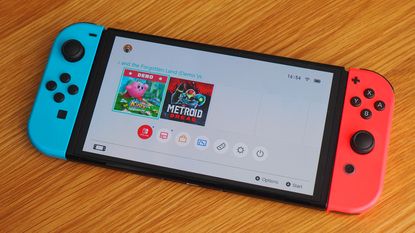It's a question on so many people's lips: should I buy the Nintendo Switch or the Switch OLED upgrade? Well, I own both versions of the console so can advise you on whether the newer, higher-spec OLED version is worth spending the extra cash on.
First thing's first though, I want to establish what's identical between the two options. Buying the original Switch versus the Switch OLED model has no bearing whatsoever on how powerful the consoles are, nor what games you can play on them. Their interior hardware is one and the same, so graphically speaking there's no difference.
That means 720p gaming on the handheld screen, or 1080p gaming on a connected TV. Nintendo can't output at higher resolutions like the PlayStation 5 or Xbox Series X, nor can it muster faster refresh rates, support variable refresh (VRR) or auto low-latency modes (ALLM) as you'll find with the more up-to-date competitor consoles. Not that, really, that'll matter for much of what you'll play on Nintendo's console anyway.
Is Switch or OLED Switch better?
So if they're sort-of the same, why would you want the Switch OLED model? The clue is in the name, of course, as it has an OLED rather than LCD panel technology. That means deeper blacks and, in my experience, a more natural colour balance (it's less warm in my opinion, but more balanced).
The other big reason to buy the Switch OLED is that its screen is larger. Not by a huge amount – it's 6.2-inch versus 7-inch on the diagonal – it's more that the bezels of the original Switch have been shrunken for the OLED edition, so you get more screen real-estate – so if you're an on-the-go gamer and love the idea of using the handheld mode then the OLED is the better option.
In addition the Switch OLED has a better rear kickstand design, so it's more adjustable, which is great if you like tabletop gaming. Oh, and importantly: there's double the storage built-in with the OLED model (64GB vs 32GB), which is still unlikely to negate your need to buy a microSD card, but it's a step up nonetheless.
- I'm not buying Nintendo Switch OLED, I'm upgrading my Switch with G-Case
- Top 5 Nintendo Switch Games 2024 – so far
Switch vs Switch OLED: Conclusion
So there we have it: the Nintendo Switch and Switch OLED can both do the same things. Games will run the same on either console and look identical on a connected TV. However, the OLED is a better panel and larger too, plus there's an improved kickstand and more internal storage.
Of the two, then, the OLED is the clear winner – but it's also the more expensive option. I'd only really opt for the OLED Switch if I was big into handheld gaming. As it stands, however, I tend to play more on the big screen and, therefore, given the price difference – see the widget below for up-to-the-minute pricing – the original Switch might actually be the better option for many people.
After all, that gap in asking price might be enough to bag you a triple-A game with the cheaper console. And there's so many amazing games on Switch that, really, that's why I think you can't lose whichever option you pick that's best suited to you.
Take a look at our Nintendo discount codes page for the latest deals from the Nintendo Store.
- The best Nintendo Switch deals (OLED included) for April 2024
- Nintendo Switch Sports review: reinventing one of the most iconic games ever



